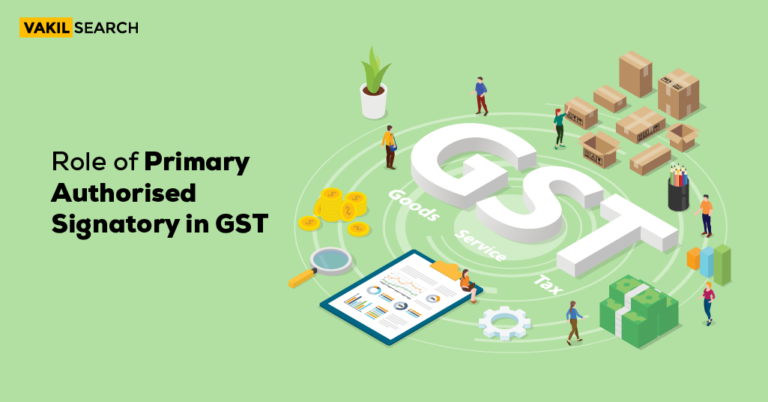Read this blog for a clear understanding of the history of Goods and Services Tax, its introduction, its components, and its importance. You will also get accurate information on how GST works.
Overview
The beginning of the concept of the Goods and Services Tax (GST) in India was in the year 2000, and it was finally implemented in 2017. It has four bills that relate to the forming of the Act. The aim of the GST Act is to level out the services and goods all across the nation. Dive in to know why GST was introduced in India.
The historical move of implementing GST gave India a significant indirect tax reform. The various different taxes that were levied at the state and the centre were clubbed into one tax that was named GST. The foremost benefit was the removal of double taxation or cascading taxation. This initiative paved the way for a single national market.
If we look at the benefit of the GST for the consumer, the reduction will be significant on the tax burden that currently stands between 30% and 25%. Because of its transparent and self-policing nature, GST is easy to administer.
Understanding the Definition of Goods and Service Tax in Detail
GST, an acronym for Goods and Services Tax, stands as a transformative indirect tax system in India, effectively replacing numerous pre-existing levies such as excise duty, VAT, and services tax. Enacted by the Parliament on 29th March 2017, GST took effect from 1 July 2017. This tax framework operates as a comprehensive, multi-stage, and destination-based system, applicable to the supply of both goods and services. Emphasizing value addition at each stage, GST serves as a unified domestic indirect tax law across the entire nation. The implementation of GST marked a significant shift from the previous complex structure of indirect tax in India, streamlining and unifying the taxation system for enhanced efficiency and transparency.
Multi-stage Supply Chain
Within a multi-stage supply chain, a product undergoes diverse transactions, traversing from raw material procurement to the eventual sale to the end consumer. This journey encompasses stages such as:
- Raw material acquisition
- Manufacturing
- Warehousing
- Wholesale distribution
- Retail sales
- Selling to end consumers.
The Goods and Services Tax (GST) is intricately integrated into each stage of this supply chain, establishing it as a multi-stage tax. The tax is applied at every juncture as the product progresses through the supply chain.
Value Addition in GST
At each stage, value is incrementally added to the product. For instance, a biscuit manufacturer adds value during the production process, and subsequent entities, such as warehousing agents and retailers, contribute to this value through packaging, labelling, and marketing. GST is levied on these successive value additions, reflecting the monetary increase at each stage leading to the final sale to the end customer.
Destination-Based Tax
GST operates on a destination-based principle. For instance, if goods are manufactured in Maharashtra but consumed by the end customer in Karnataka, the tax revenue generated by GST is allocated to Karnataka, the point of consumption. This ensures that the tax revenue aligns with the location of consumption, adding a destination-based dimension to the GST system.
When Was Introduced GST in India?
GST was introduced in India on 1 July 2017 after the Parliament passed the Goods and Service Tax Act on 29 March 2017.
Why Was Introduced GST in India?
Before the introduction of GST, the taxation system in India lent itself to various problems. GST Registration Process was introduced to provide relief from these problems. GST:
- Subsumed majority of the indirect taxes
- Removed the cascading effect of taxes
- Stopped evasion of taxes
- Increased taxpayer base
- Provided online procedures to increase the ease of doing business
- Made the distribution system and logistics better
- Promoted consumption and competitive pricing.
The Journey of GST in India
When a committee was established in 2000 to prepare legislation, the GST journey officially started. The Law didn’t change for another seventeen years after then. The GST Bill was approved by the Rajya Sabha and Lok Sabha in 2017. Saw the implementation of the GST Law on 1 July 2017.
2000: Formation of Empowered Committee with State Finance Ministers
2006: P Chidambaram announces GST for 1 April 2010
2009: Empowered Committee submits first GST discussion paper
2010: President Pranab Mukherjee delays GST, proposes April 2011
2011: Introduction of Constitution (115th Amendment) Bill in Lok Sabha and Referral to Standing Committee on Finance
2013: Standing Committee on Finance reports on Constitution (115th Amendment) Bill
2014: Lok Sabha dissolution leads to lapse.Introduction of Constitution (122nd Amendment) Bill focusing on GST
2015: Lok Sabha passes Bill, referred to Select Committee in Rajya Sabha. Select Committee submits report. Chief Economic Advisor-led Committee reports on possible GST rates
2016:
- Bill passed, notified as Constitution (101st Amendment) Bill
- Assam first state to ratify
- President Pranab Mukherjee gives assent
- Union Cabinet approves GST Council, first meeting in New Delhi.
2017:
- Introduction of CGST, IGST, UTGST Bills in Lok Sabha
- Bills passed, leading to notification of GST Acts
- GST Council notifies rates and cess.
- Official GST rollout on July 1.
2018:
- Introduction of TDS provisions and GSTR-7 filing
- Implementation of the E-way bill system for inter-state goods movement.
2019:
- Application of reverse charge mechanism
- Restrictions on ITC availability for Section 36(4).
2020:
- Voluntary introduction of e-invoicing
- Quarterly return monthly payment scheme
- June – Relief to taxpayers due to COVID-19.
2021:
- Introduction of GSTR-8 and GST on e-commerce-supplied restaurant services.
- Implementation of GST on State Govt. services guaranteeing loans to undertakings or PSUs.
Different Types/ Components of GST in India
In India, four different types of GST have been implemented:
- Integrated Goods and Services Tax (IGST)
- State Goods and Services Tax (SGST)
- Central Goods and Services Tax (CGST)
- Union Territory Goods and Services Tax (UTGST)
Under each version of GST, the rate of taxation is different.
The following table provides the difference between each type of GST at a glance.
| GST Type | Benefitting Authority | Priority of Tax Credit Use | Collecting Authority | Applicable Transactions (Goods and Services) | Governing Act |
| CGST | Central Government | CGST IGST | Central Government | Intrastate – Within a Single State | CGST Act |
| SGST | State Government | SGST IGST | State Government | Intrastate – Within a Single State | SGST Act |
| IGST | Central Government and State Government | IGST CGST | Central Government | Interstate – Between a State and a Union Territory or Between Two States | IGST Act |
| UGST / UTGST | Union Territory (UT) Government | UTGST IGST | Union Territory (UT) Government | Within one single UT | UTGST Act |
Importance of GST
GST is levied on goods and services that are sold for consumption domestically. This tax is part of the final price of the good or service, and the final consumer needs to pay it when purchasing. The seller passes the collection to the government. Generally, GST is taxed at one rate all throughout the country.
The following list provides some of the important advantages of GST.
- Price reduction: Traders and manufacturers do not need to include taxes in their production cost, due to which the cost of production will decrease
- Reduction in procedural costs and compliance requirements: GST lends itself to decreasing compliance maintenance load and does away with the need to maintain separate records for IGST, SGST, and CGST.
- Implement Unified GST: While dual GST has been implemented in India, it will lead to a Unified GST, the Indirect Tax method
- Increase GDP growth by 100-200 bps or (1 to 2%): Due to GST providing a uniform structure of taxation, it will encourage cheaper and faster goods movement all over the nation
- Attract foreign investment: GST will display to foreign investors the ability created to support business.
Use our GST calculator to determine the exact amount of GST to be paid before registering for GST.
Objectives Of GST
One Nation, One Tax Ideology
- GST replaces multiple indirect taxes, ensuring a single tax rate across states
- Centralised decision-making simplifies tax administration, introducing common laws like e-way bills and e-invoicing
- Unified system enhances tax compliance with streamlined return processes.
Subsuming Multiple Taxes
- GST consolidates diverse indirect taxes, reducing compliance burden and easing administration
- Eradicates the need for state-specific levies, creating a centralised tax on goods and services.
Eliminating Cascading Effect
- GST aims to eliminate tax cascading by allowing set-off credits at each supply chain stage
- Ensures tax is levied only on the net value added, promoting seamless flow of input tax credits.
Curbing Tax Evasion
- Stringent GST laws minimise chances of input tax credit fraud through invoice verification
- Nationwide applicability and centralised surveillance system expedite action against defaulters, curbing tax evasion.
Expanding Taxpayer Base
- GST’s consolidated nature increases tax-registered businesses.
- Stricter input tax credit laws bring unorganized sectors, like the construction industry, under the tax net.
Online Procedures for Ease
- GST procedures are entirely online, from registration to return filing, contributing to ease of doing business.
- The upcoming central portal for indirect tax compliance will further streamline processes.
Improved Logistics and Distribution
- A single tax system reduces documentation needs, cutting transportation cycle tihttps://vakilsearch.com/gst/return-filingmes and improving supply chain efficiency.
- E-way bill system eliminates interstate checkpoints, enhancing transit and destination efficiency.
Promoting Competitive Pricing and Consumption
- Uniform GST rates lead to competitive pricing, addressing imbalances between states and global markets
- Increased consumption and higher revenues signify successful achievement of GST objectives.
How the Goods and Services Tax Works?
GST has managed to remove most of the indirect taxes levied by the State and Central governments.
GST Rates
GST provides a 4-tier tax structure for all services and goods to be used for the calculation of applicable GST on a specific good or service. The 4 tax rates are 5%, 12%, 18%, and 28%. GST is exempt for several goods and services. The GST rate for precious metals, such as silver and gold, is 3%.
Input Tax Credit
Input tax credit enables manufacturers and service providers to offset their input costs when they pay their output tax.
Let us take an example:
Consider that a manufacturer’s output tax adds up to ₹2,000. The manufacturer has paid an input tax of ₹800 when making the purchase. Now, the manufacturer’s liability for GST will be ₹1,200 (₹2,000 – ₹800). The compliance required is that the invoices need to match the claim so that the manufacturer can benefit from the credit facility.
Export and Import GST
On the import of goods, the IGST component of GST is applicable. This is because an import is seen as being an inter-state transaction. Besides the IGST that is applicable in this case, the import of goods also attracts additional customs duties. On the other hand, there is no tax liability in the case of the export of goods/ services. Yet, exporters are allowed the advantage of an input tax credit.
India’s Adoption of the Goods and Services Tax
The Goods and Services Tax (GST) is a consumption tax or an indirect tax that is imposed on the supply of services and goods. GST is a destination-based, multistage, comprehensive tax.
Destination-based: Unlike previous taxes that were collected from the point of origin, GST is collected from the point of consumption.
Multi-staged: While GST is applicable at each step of the process of production, it is refunded to all parties at the various stages of production other than to the final consumer
Comprehensive: It subsumes nearly all indirect taxes (besides some state taxes).
Tax Laws Before GST
- In the previous tax system, both state and central governments imposed numerous indirect taxes, such as VAT, leading to confusion with different rules for each state
- Inter-state sale of goods was taxed by the central government through Central State Tax (CST), and various other taxes like entertainment tax and octroi were imposed by both state and central governments, causing overlapping and complexity
- The taxation structure resulted in a cascading effect, where goods were subject to multiple taxes. For example, excise duty by the central government and VAT by the state were both charged on manufactured goods
- The list of pre-GST indirect taxes included Central Excise Duty, Duties of Excise, Additional Duties of Excise, Additional Duties of Customs, Special Additional Duty of Customs, Cess, State VAT, Central Sales Tax, Purchase Tax, Luxury Tax, Entertainment Tax, Entry Tax, Taxes on advertisements, and Taxes on lotteries, betting, and gambling
- To simplify this complex system, GST was introduced, replacing all the previous taxes with CGST, SGST, and IGST
- Certain transactions involving non-GST goods like petroleum crude, high-speed diesel, petrol, natural gas, aviation turbine fuel, and alcoholic liquor for human consumption are still subject to GST, but at a concessional rate of 2%
- This concessional GST rate applies specifically to transactions involving resale, use in manufacturing or processing, and use in sectors such as telecommunications, mining, electricity generation or distribution, and other power sectors.
Conclusion
The importance of GST implementation can be seen in the many advantages that it brings to the taxation system in India. It is a major step forward in significantly reforming India’s indirect taxation system. The bringing together of various state and central taxes under a single tax enables the removal of double taxation, and this lends itself to creating a common national market.
Frequently Asked Questions
Why are we using the GST in India?
GST (Goods and Services Tax) was implemented in India to simplify the complex indirect tax structure. It replaced multiple taxes, streamlining tax administration, eliminating the cascading effect of taxes, curbing tax evasion, and fostering a unified and transparent tax system.
Which state first introduced GST in India?
Assam was the first state to ratify the GST Constitutional Amendment Bill, making it the initial state to introduce GST in India.
Who was the first CEO of GST?
Navin Kumar, an Indian Revenue Service officer, served as the first Chief Executive Officer (CEO) of the Goods and Services Tax Network (GSTN), the IT backbone of the GST system in India.










